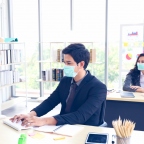With restrictions on covid-19 easing, non-essential retailers and schools are on track to re-open in the first and second week of June.
However, the world we know will be very different to the one before – and every place of interest will require formal practices and procedures to maintain cleanliness and prevent a second wave of coronavirus spreading.
With this in mind, we spoke to hygiene specialists, Trovex, to get an insight into how to make a commercial building hygienic.
Putting hygiene first
Hygiene must be very much become part of the company’s culture and something that all staff members and customers must participate in.
This could mean putting someone in charge of hygiene or greeting customers at the front of the store and making the best practices clear.
Any additional signs, protective screens and clothing would be welcomed to limit the spread.
This includes handing out gloves, masks, encouraging social distancing and also checking the health of any staff members and whether they come into contact with customers and any other staff.
Having hand sanitiser available at every corner is important and making sure that this is stocked up and not empty. For hospitals and clinics, it is common to have hand wash stations and hand sanitiser at the entrance of every room – and putting up signs to encourage this.
If the culture of hygiene is instilled into staff members and daily procedures, you are on track to creating a clean environment.
Staying on top of your supplies
To keep your buildings clean will require having all the right amounts of cleaning products including sprays, hand gels and liquids – and these are quickly becoming scarce amongst the influx of purchases from panic buyers.
Make sure that you can stay on top of your supplies and you can do this by checking with your suppliers and always looking for alternatives. It may be worth being slightly overstocked, just in case these products become hard to get hold of.
Trovex, and other suppliers, offer a range of materials that are made for hygiene purposes. This includes doors, walls, ceilings and panels that are PVC, wrapped or encapsulated. Usually created under high pressure, high temperature and vacuum-bonded, these types of materials create an impermeable barrier to moisture and bacteria and maximise hygiene.
You will notice that a lot of new schools (like academy schools), clinics and hospitals will use this type of wall cladding, which makes it easier to clean. When compared to tiles which are prone to getting grit and other dirt caught between the cracks, having panels is a much more hygienic approach for your interiors.
In addition, you can design for hygiene by having good ventilation and lots of windows and good ceiling heights. Any small and claustrophobic rooms are going to be a hotbed for germs and if someone who is infected coughs or sneezes, it will have less of a chance to escape.
Keeping a cleaning schedule
Banks, supermarkets and other high traffic areas will always have cleaning schedules – but it may be more important than ever to adhere and monitor them. In fact, it could be worth making extra cleaning schedules and more frequently to reduce the risk of any disease spreading.

